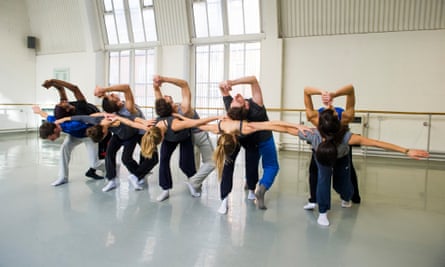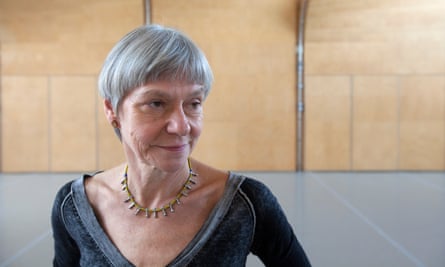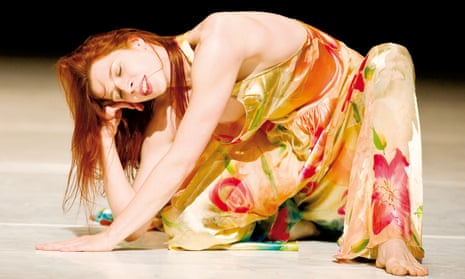Pina Bausch was just 68 when she choreographed Como el Musguito … and she had no notion that it would be the final work of her career. Now, as the production returns to London, it’s hard to separate what we see on stage from the poignancy of Bausch’s premature death – hard not to see this tender, playful, often piercingly poetic work as an elegy for its creator.
In fact, the sweetness which illuminates parts of Como el Musguito … is far from being specific to that 2009 production. While Bausch’s earlier creations had the qualities of a nightmare, in their bleak, absurd fantasies and their compulsively played-out rituals, her later work had lightness and a more sensuous ease. That shift in tone was partly physical – the choreographer was working with a significantly more youthful company and was choosing to celebrate the beauty of their dancing bodies. Yet it had a spiritual dimension too, as if Bausch had exorcised the demons that haunted her earlier works, as if she were speaking through the dancer in Como el Musguito … who declares: “I’ve learned to live in the moment and I like it.”
Of course, we have no idea how Bausch’s career might have progressed if she’d lived any longer. We might have ended up describing her “late phase” in very different terms: or alternatively there might have been no new work to describe. As hard as it is to imagine, Bausch might simply have stopped.
Organising a studio of dancers, moulding bodies into potent, expressive or beautiful moves, can be hard physical work and once one factors in the demands of running a company and going out on tour, it’s not surprising that many choreographers opt to retire earlier than their writing or composing peers. Only recently, the 70-year-old Swedish choreographer Mats Ek announced he was stopping work, while Lloyd Newson, 58-year-old director of DV8, has said that he is taking an extended break.
Certainly Richard Alston has come to feel that at 67, he’s part of a shrinking minority: “There aren’t many of us older ones around.” Yet he believes that “mature choreographers are terrific” and is convinced that his own best work still lies ahead: “In the studio I’m as excited as I’ve always been. I know more about what it is that I particularly do; I know that I’m very particular about rhythm and phrasing and that I love fast steps. And because I know more, I can get closer to what I want to make.”

Alston admits that his own brand of musically inspired dance-making may be easier to sustain than the more concept- or narrative-driven physical theatre that Newson creates. There are always new scores waiting to be used, and in the studio Alston finds music is: “An incredibly strong and sustaining force – I’ve never felt stuck for ideas.” He’s also energised by the dancers around him, not only those within his company, but guest artists from other genres, with whom he’s been collaborating recently. He’s fascinated by the shapes, the musculature, the physical root of forms such as hip-hop and South Asian dance and as confident as he is in his own language, he’s openly curious as to how it shifts and adapts to the presence of radically different influences, such as the young kathak dancer Vidya Patel.
A different version of Alston’s open-mindedness has dictated the career trajectory of 65-year-old Siobhan Davies. Over a decade ago, Davis made a radical break from the mainstream stage, in order to focus on the qualities that most moved her in dance: the body’s rich and largely untapped capacity for subtle nuances of expression. She began making work for smaller, intimate spaces like galleries; she also began to examine her own concept of dance, exploring its interaction with other disciplines such as writing, film and science, and connecting with choreographers formed by very different practices and philosophies. “My studio, to my delight, has become a hub for other artists, not in my generation, to rummage into what they can connect and contribute to. I like it to be humming with conversation and making.”

The late and very great Merce Cunningham continued “humming” until the final months of his life. Significantly, the works which most looked like “late Cunningham” were those he created during his 60s – his last dancing years – in which he appeared like a fragile, embattled Lear (Quartet, 1982), or a Prospero conjuring up beautiful images from the younger dancers around him (Pictures, 1984). The works he went on to make in his 70s and 80s had a very different energy, though, as Cunningham not only began to work with a younger generation of musicians, such as Radiohead, but discovered the possibilities of digitally created design.
Dances of epic scale and wonder such as Biped, with their richly futuristic imagery, were products not only of a magisterial craft but an apparently ageless curiosity. Cunningham was pretty much choreographing until his death in 2009 and that’s how 74-year-old Twyla Tharp plans to go. Having just celebrated her own half-century of dance-making, she also thinks she’s getting smarter and more experienced with age. When an interviewer recently dared ask if she had any plans to retire, Tharp’s response was typically and loftily brusque: “I can’t imagine why we would want to discuss that subject.” Yet she was holding up a torch for senior choreographers everywhere when she added: “We use what we have to push forward … everything is a launching platform for what comes next.”
- „…como el musguito en la piedra, ay si, si, si…“ (Like Moss on a Stone) is at Sadler’s Wells, London, 11-14 February. Box office: 020 7863 8000.

Comments (…)
Sign in or create your Guardian account to join the discussion